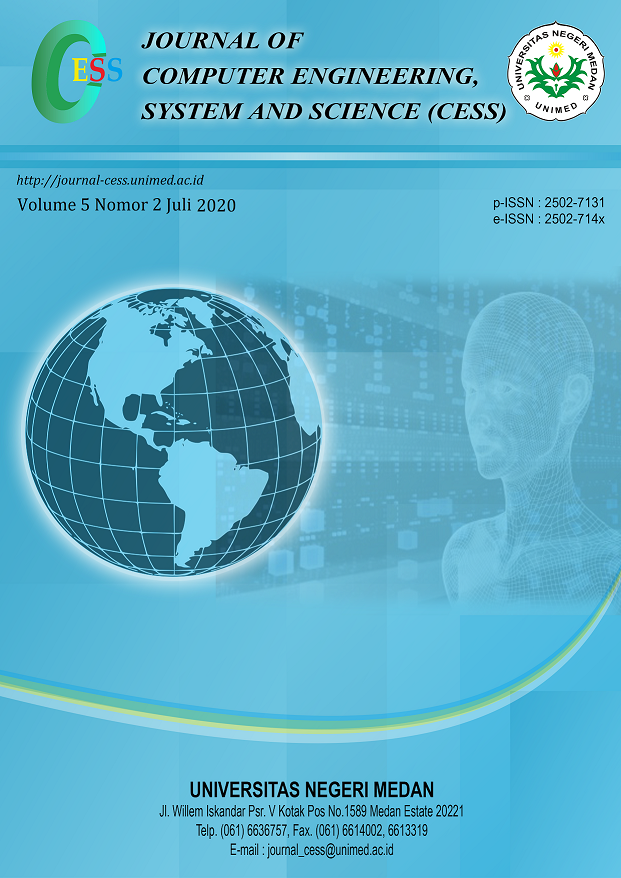Pengenalan Bentuk Tangan secara Real Time Menggunakan Leap Motion dan K-Nearest Neighbors sebagai Sistem Kendali Robot Beroda
DOI:
https://doi.org/10.24114/cess.v5i2.18141Keywords:
Sistem kendali, robot beroda, leap motion, pembentukan fitur, k-nearest neighborsAbstract
Sistem kendali robot saat ini telah banyak dibuat dengan menggunakan berbagai metode seperti sensor accelerometer, sensor suara, leap motion. Pada penelitian ini diusulkan pengenalan bentuk tangan secara real time menggunakan leap motion dan K-Nearest Neighbors (KNN) sebagai sistem kendali robot beroda. Leap motion digunakan untuk mendeteksi titik koordinat posisi tangan pada pandangan leap motion. pembentukan fitur dilakukan dengan mengukur jarak euclidean distance antara palm position dengan finger tip. KNN digunakan untuk menentukan kelas pada data testing. Uji coba dilakukan menggunakan tangan penulis dengan 5 jenis instruksi yaitu maju, mundur, stop, belok kanan, belok kiri dan setiap instruksi di ujicoba sebanyak 20 kali percobaan. Dari hasil ujicoba yang dilakukan menunjukkan bahwa sistem yang diusulkan memiliki tingkat akurasi pengenalan 94%.Downloads
References
Supria, Supria, and Nurul Fahmi. "Sistem Remote Control Robot Beroda Menggunakan Teknologi Leap Motion." Digital Zone: Jurnal Teknologi Informasi Dan Komunikasi 9.1 (2018): 1-11.
A. N. Arvindan and D. Keerthika, œExperimental investigation of remote control via Android smart phone of arduino-based automated irrigation system using moisture sensor, in 2016 3rd International Conference on Electrical Energy Systems, ICEES 2016, 2016, pp. 168“175.
Y. Hendriana and R. Hardi, œRemote control system as serial communications mobile using a microcontroller, in 2016 International Conference on Information Technology Systems and Innovation, ICITSI 2016 - Proceedings, 2017.
A. Widiyanto and N. Nuryanto, œRancang Bangun Mobil Remote Control Android dengan Arduino, Creat. Inf. Technol. J., vol. 3, no. 1, p. 50, 2016.
J. P. Ventura, N. A. Cruz, and F. P. Lima, œA remote monitoring and control system for ecosystem replication experiments, in OCEANS 2016 MTS/IEEE Monterey, OCE 2016, 2016.
E. D. Tica, L. A. PeriÈ™oara, and A. Vasile, œAn arduino platform for remote control and bus testing of programmable instruments, 2017, pp. 308“311.
Supria, Supria, Darlis Herumurti, and Wijayanti Nurul Khotimah. "PENGENALAN SISTEM ISYARAT BAHASA INDONESIA MENGGUNAKAN KOMBINASI FITUR STATIS DAN FITUR DINAMIS LMC BERBASIS L-GCNN." JUTI: Jurnal Ilmiah Teknologi Informasi 14.2 (2016): 217-230.
R. Fernando, S. Supria, and M. Nasir, œAplikasiMarawis Digital Menggunakan Sensor Leap Motion, vol. 2, no. 2, 2017.
K. Y. Fok, N. Ganganath, C. T. Cheng, and C. K. Tse, œA Real-Time ASL Recognition System Using Leap Motion Sensors, in Proceedings - 2015 International Conference on Cyber-Enabled Distributed Computing and Knowledge Discovery, CyberC 2015, 2015, pp. 411“414.
Humaira, Fitrah, et al. "Real Time SIBI Sign Language Recognition Based on K-Nearest Neighbor." Proceeding of the Electrical Engineering Computer Science and Informatics 5.5 (2018): 669-673.
M. Mohandes, S. Aliyu, and M. Deriche, œArabic sign language recognition using the leap motion controller, in IEEE International Symposium on Industrial Electronics, 2014, pp. 960“965.
W. N. Khotimah, R. A. Saputra, N. Suciati, and R. R. Hariadi, œComparison between Back Propagation Neural Network and Genetic Algorithm Back Propagation Neural Network for Sign Language Recognition, vol. 0, pp. 0“5, 2015.
S. Tan, œNeighbor-weighted K-nearest neighbor for unbalanced text corpus, Expert Syst. Appl., vol. 28, no. 4, pp. 667“671, 2005.
Downloads
Published
How to Cite
Issue
Section
License
Copyright (c) 2020 Computer Engineering, Science and System Journal

This work is licensed under a Creative Commons Attribution 4.0 International License.















